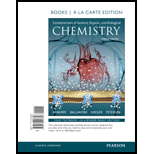
Modified Masteringchemistry With Pearson Etext -- Valuepack Access Card -- For Fundamentals Of General, Organic, And Biological Chemistry
8th Edition
ISBN: 9780134261270
Author: John E.; Ballantine, David S.; Hoeger, Carl A.; Peterson, Virginia E. Mcmurry
Publisher: Prentice Hall
expand_more
expand_more
format_list_bulleted
Concept explainers
Question
Chapter 18, Problem 18.80AP
Interpretation Introduction
Interpretation:
The difference between simple protein and conjugated protein has to be identified.
Concept introduction:
Simple protein has only amino acid residues.
Conjugated protein has one or more non-amino acid unit.
Classes of protein include,
- Fibrous protein
- Globular protein
- Simple protein
- Conjugated protein
- Native protein
- Mobile protein
- Cellular protein
Expert Solution & Answer
Want to see the full answer?
Check out a sample textbook solution
Students have asked these similar questions
What is the difference between a simple protein and a conjugated protein?
Can a conjugated protein be also a monomeric protein?
What kinds of molecules provide the nonprotein part of a conjugated protein? Give an example.
Chapter 18 Solutions
Modified Masteringchemistry With Pearson Etext -- Valuepack Access Card -- For Fundamentals Of General, Organic, And Biological Chemistry
Ch. 18.2 - Prob. 18.1PCh. 18.2 - Prob. 18.2PCh. 18.3 - Prob. 18.3PCh. 18.3 - Examine the ball-and-stick model of valine in the...Ch. 18.3 - Indicate whether each of the following molecules...Ch. 18.3 - Prob. 18.6PCh. 18.3 - Prob. 18.7KCPCh. 18.3 - Prob. 18.8PCh. 18.3 - Prob. 18.9PCh. 18.3 - Prob. 18.10P
Ch. 18.3 - Prob. 18.11PCh. 18.3 - Prob. 18.12PCh. 18.4 - The proteins collagen, bovine insulin, and human...Ch. 18.4 - Prob. 18.2CIAPCh. 18.4 - Prob. 18.13PCh. 18.4 - Prob. 18.14PCh. 18.5 - Valine is an amino acid with a nonpolar side...Ch. 18.5 - Tripeptides are composed of three amino acids...Ch. 18.5 - Prob. 18.17PCh. 18.5 - Identify the amino acids in the following...Ch. 18.5 - Prob. 18.19PCh. 18.5 - Prob. 18.3CIAPCh. 18.5 - Prob. 18.4CIAPCh. 18.5 - Two of the most complete (balanced) proteins...Ch. 18.6 - Prob. 18.6CIAPCh. 18.6 - Prob. 18.7CIAPCh. 18.6 - (a)What atoms are present in a planar unit in a...Ch. 18.6 - Prob. 18.21PCh. 18.6 - Prob. 18.22PCh. 18.7 - Prob. 18.23PCh. 18.7 - Prob. 18.24PCh. 18.7 - Complete the following two sentences with either...Ch. 18.7 - Prob. 18.26KCPCh. 18.8 - Which of the following pairs of amino acids can...Ch. 18.8 - Look at Table 18.3 and identify the type of...Ch. 18.8 - In Figure 18.3, identify the amino acids that have...Ch. 18.8 - Prob. 18.30PCh. 18.9 - Prob. 18.31PCh. 18.10 - Another endoprotease is trypsin. Trypsin...Ch. 18.10 - Prob. 18.33PCh. 18.10 - Prob. 18.8CIAPCh. 18.10 - Prob. 18.9CIAPCh. 18 - Draw the structure of the following amino acids,...Ch. 18 - Prob. 18.35UKCCh. 18 - Prob. 18.36UKCCh. 18 - Prob. 18.37UKCCh. 18 - Prob. 18.38UKCCh. 18 - Threonine has two chiral centers. Draw L-threonine...Ch. 18 - Name four biological functions of proteins in the...Ch. 18 - Prob. 18.41APCh. 18 - Prob. 18.42APCh. 18 - Prob. 18.43APCh. 18 - Prob. 18.44APCh. 18 - Prob. 18.45APCh. 18 - Prob. 18.46APCh. 18 - Prob. 18.47APCh. 18 - Draw leucine and identify any chiral carbon atoms...Ch. 18 - Prob. 18.49APCh. 18 - Prob. 18.50APCh. 18 - Is histidine hydrophilic or hydrophobic? Explain...Ch. 18 - Prob. 18.52APCh. 18 - At neutral pH, which of the following amino acids...Ch. 18 - Prob. 18.54APCh. 18 - Prob. 18.55APCh. 18 - Prob. 18.56APCh. 18 - Prob. 18.57APCh. 18 - Proteins are usually least soluble in water at...Ch. 18 - Prob. 18.59APCh. 18 - Prob. 18.60APCh. 18 - Prob. 18.61APCh. 18 - Prob. 18.62APCh. 18 - Prob. 18.63APCh. 18 - (a)Identify the amino acids present in the peptide...Ch. 18 - Prob. 18.65APCh. 18 - Prob. 18.66APCh. 18 - Prob. 18.67APCh. 18 - Prob. 18.68APCh. 18 - Prob. 18.69APCh. 18 - Prob. 18.70APCh. 18 - Prob. 18.71APCh. 18 - Prob. 18.72APCh. 18 - Prob. 18.73APCh. 18 - Prob. 18.74APCh. 18 - Prob. 18.75APCh. 18 - What kind of bond would you expect between chains...Ch. 18 - Is the bond formed between each pair in Problem...Ch. 18 - Prob. 18.78APCh. 18 - Prob. 18.79APCh. 18 - Prob. 18.80APCh. 18 - Prob. 18.81APCh. 18 - Prob. 18.82APCh. 18 - Prob. 18.83APCh. 18 - Prob. 18.84APCh. 18 - Prob. 18.85APCh. 18 - Prob. 18.86APCh. 18 - Prob. 18.87APCh. 18 - Prob. 18.88APCh. 18 - Give an example of a protein that has quaternary...Ch. 18 - Prob. 18.90APCh. 18 - Prob. 18.91APCh. 18 - Prob. 18.92APCh. 18 - Prob. 18.93APCh. 18 - Prob. 18.94APCh. 18 - Prob. 18.95APCh. 18 - Prob. 18.96APCh. 18 - Prob. 18.97APCh. 18 - Prob. 18.98CPCh. 18 - Prob. 18.99CPCh. 18 - Prob. 18.100CPCh. 18 - Prob. 18.101CPCh. 18 - Prob. 18.102CPCh. 18 - Prob. 18.103CPCh. 18 - Prob. 18.104CPCh. 18 - Prob. 18.105CPCh. 18 - Prob. 18.106CPCh. 18 - Prob. 18.107CPCh. 18 - Prob. 18.108CPCh. 18 - Prob. 18.109GPCh. 18 - Prob. 18.110GPCh. 18 - Prob. 18.111GPCh. 18 - Prob. 18.112GP
Knowledge Booster
Learn more about
Need a deep-dive on the concept behind this application? Look no further. Learn more about this topic, biochemistry and related others by exploring similar questions and additional content below.Similar questions
- Which is the major force responsible for the formation of an α-helix in protein secondary structure?arrow_forwardWhat is a mutation, and how might it result in a change in the primary structure of a protein?arrow_forwardwhat are the four interactions that keep the protein structure intact?arrow_forward
arrow_back_ios
arrow_forward_ios
Recommended textbooks for you
 Human Heredity: Principles and Issues (MindTap Co...BiologyISBN:9781305251052Author:Michael CummingsPublisher:Cengage Learning
Human Heredity: Principles and Issues (MindTap Co...BiologyISBN:9781305251052Author:Michael CummingsPublisher:Cengage Learning

Human Heredity: Principles and Issues (MindTap Co...
Biology
ISBN:9781305251052
Author:Michael Cummings
Publisher:Cengage Learning
Macromolecules | Classes and Functions; Author: 2 Minute Classroom;https://www.youtube.com/watch?v=V5hhrDFo8Vk;License: Standard youtube license